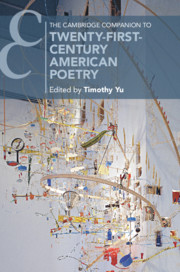Book contents
- The Cambridge Companion to Twenty-First-Century American Poetry
- The Cambridge Companion to Twenty-First-Century American Poetry
- Copyright page
- Contents
- Notes on Contributors
- Chronology
- Introduction
- 1 New Black Aesthetics: Post–Civil Rights African American Poetry
- 2 Traditions of Innovation in Asian American Poetry
- 3 Locations of Contemporary Latina/o Poetry
- 4 Sovereign Poetics and Possibilities in Indigenous Poetry
- 5 Changing Topographies, New Feminisms, and Women Poets
- 6 The Nearly Baroque in Contemporary Poetry
- 7 Disability Aesthetics and Poetic Practice
- 8 Queer Poetry and Bioethics
- 9 Trauma and the Avant-Garde
- 10 Blockade Chants and Cloud-Nets: Terminal Poetics of the Anthropocene
- 11 Give Me Poems and Give Me Death: On the End of Slam(?)
- 12 Anti-capitalist Poetry
- 13 Of Poetry and Permanent War in the Twenty-First-Century
- 14 Poetry in the Program Era
- 15 The Future of Poetry Studies
- Further Reading
- Index
- Cambridge Companions to …
- References
7 - Disability Aesthetics and Poetic Practice
Published online by Cambridge University Press: 25 February 2021
- The Cambridge Companion to Twenty-First-Century American Poetry
- The Cambridge Companion to Twenty-First-Century American Poetry
- Copyright page
- Contents
- Notes on Contributors
- Chronology
- Introduction
- 1 New Black Aesthetics: Post–Civil Rights African American Poetry
- 2 Traditions of Innovation in Asian American Poetry
- 3 Locations of Contemporary Latina/o Poetry
- 4 Sovereign Poetics and Possibilities in Indigenous Poetry
- 5 Changing Topographies, New Feminisms, and Women Poets
- 6 The Nearly Baroque in Contemporary Poetry
- 7 Disability Aesthetics and Poetic Practice
- 8 Queer Poetry and Bioethics
- 9 Trauma and the Avant-Garde
- 10 Blockade Chants and Cloud-Nets: Terminal Poetics of the Anthropocene
- 11 Give Me Poems and Give Me Death: On the End of Slam(?)
- 12 Anti-capitalist Poetry
- 13 Of Poetry and Permanent War in the Twenty-First-Century
- 14 Poetry in the Program Era
- 15 The Future of Poetry Studies
- Further Reading
- Index
- Cambridge Companions to …
- References
Summary
American poets increasingly began to bring disability into their poetry in a more direct way in the 1980s and 1990s. Along with their embodied experiences living with disability, the work of many of these poets represents their involvement in the disability rights movement and disability culture and puts disability at the center of the poetry by writing primarily for disabled (rather than nondisabled) readers. I call the twenty-first-century poets who continue this tradition of disability culture poetry “crip poetry.” Examples discussed include Meg Day, Leah Lakshmi Piepzna-Samarasinha, Amber DiPietra, Denise Leto, Petra Kuppers, Neil Marcus, Constance Merritt, and Molly McCully Brown. In contrast, I call the twenty-first-century poets who develop disability poetics that are not written primarily for disabled audiences, and that are often based in other aesthetic movements and/or identities, “disability poetry.” Examples discussed include Bettina Judd, Airea Matthews, David Wolach, and Brian Teare.
- Type
- Chapter
- Information
- The Cambridge Companion to Twenty-First-Century American Poetry , pp. 106 - 119Publisher: Cambridge University PressPrint publication year: 2021



